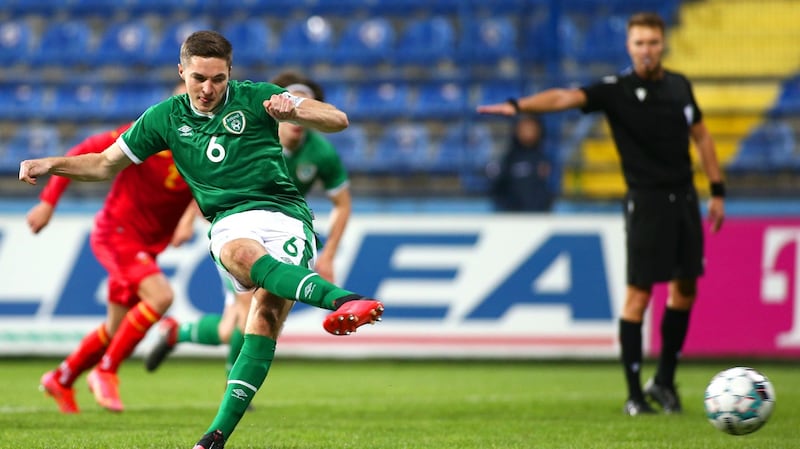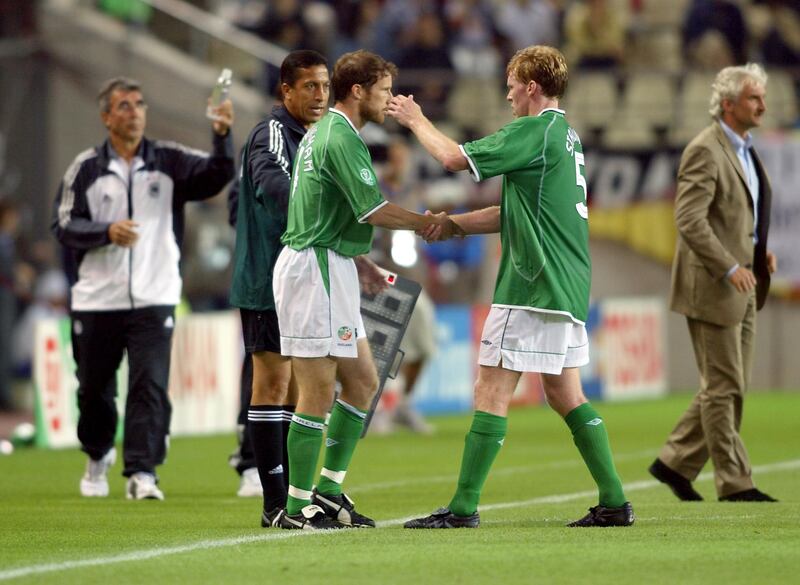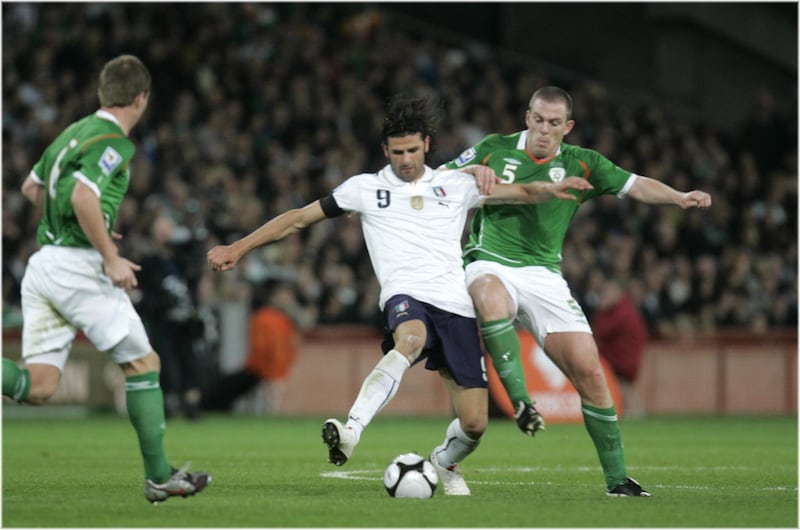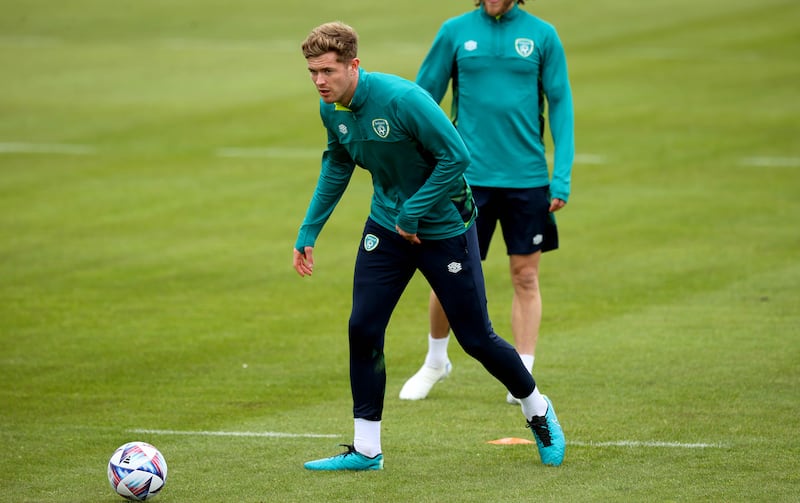Kenny Cunningham cannot remember much from 20 years ago. Nor does he need to. Despite being Ireland captain from 2003 and right through Brian Kerr’s managerial period, the 2002 World Cup was mostly about sitting on the bench and simply existing amid the chaos.
This is not another Saipan article.
There was barely any mention of the Pacific island meltdown in an interesting conversation this week with the 50-year-old former centre half.
“That argument goes round and round in circles.”
READ MORE
The current wave of defenders at Stephen Kenny’s disposal got a longer airing. As does Jim Crawford’s under-21s being on the cusp of qualifying for the Euros. That would be a first. He particularly likes Conor Coventry and the idea of fast-tracking the MK Dons midfielder into the senior squad to sit alongside Josh Cullen and mind the fort as the era of wing backs and floating number 10s grips hold of Irish football.
“Josh Cullen is not quick, he’s not Roy, but he does so much; intercepting, tiger-ish tackles, getting across the midfield, getting the team going, getting possession and moving it while always staying behind the ball, so it would be nice to see another with a similar mindset in there beside him. Someone like Coventry would give me a lot more confidence in the wing backs and front three.
“Look at the under-21s last-minute goal against Sweden in Tallaght, look at the ball Coventry played under pressure, he threaded it right through – so he can pass.”

As Cunningham warmed to the unending topic of what the Republic of Ireland can become, we look at what they once were. We mention the war. Or the aftermath of that unholy clash of personalities that leaves shrapnel in the Irish psyche.
We speak about Cunningham’s chunk change minutes against Germany when everything changed forever more. When the other Keane, Robbie not Roy, kept the journey going with an acrobatic finish before his rolly polly celebration in the corner was cloaked by everyone bar one.
“Don’t remember even touching the ball,” said Cunningham, “I remember the noise and thinking ‘just stay calm here’. I was only one who didn’t run over to Robbie. I just turned back and got my head straight.”
Already 30 years old, and an elder in football dressing rooms, suddenly experiencing the chill of retirement normally visited upon 60-somethings, who tend to embrace the next chapter of their lives, Cunningham remembers the fear that coursed through his body when Mick McCarthy called his number - and not Dunne’s - to replace a flagging Steven Staunton.
“I’ve never been so nervous playing football. My stomach was churning, proper fear.”
Really? But you had seen it all?
“Not at a World Cup! Mick caught me by surprise. As I went out to warm up I was really fighting it, the stomach was like a tumble dryer.

“Stan’s legs were shot in the Spain game as well so I’d a longer run into extra-time. But I felt for Richard as he had played so well in qualification games. Especially with me coming on. There would have been an argument to get Richard on ahead of me, but you push that to one side, but I do remember looking at him and thinking he should feel hard done by.”
What about Dunne then? Many peoples’ memories linger on the fact that McCarthy went with Garry Breen, a centre half in his own likeness, and Staunton ahead of the rising Dunne or established Cunningham.
“I’d had an injury that kept me out for six months. I remember watching the match in Holland at home, when we went two-nil up and Richard came in for one of his first starts and played really well. It looked like he would stay in the team.
“I’d feel deflated about that still if I was Richard but he’d never say it. He’s not that type.
“Stan’s left foot, his delivery and ability to get us going from back to front, was very important to the team. And his experience.
“But Richard was the one for me. He had it all – pace, power, excellent on the ball. He took defending for Ireland to a different level under Trapattoni but he didn’t play a minute at that World Cup. He could have come into the team and there wouldn’t have been a drop off.
“He eventually played at a major tournament at the Euros in 2012.”

No real need to celebrate the 10-year anniversary of Ireland fans being happy just to be there. Of Sopot nights and our shoeless ceo – say it ain’t so, John, and release the emails – and paying the toll for years of standing still.
With a little more prodding, Cunningham remembers the Spain match. He remembers Staunton running out of steam. He remembers McCarthy nodding to him – not Dunne – to hold the line for 70 minutes, including extra-time, when he was marking nobody because the Spanish ran out of subs.
“Was it Raul who came off? I never realised they were down to 10 men to be honest.
“I was playing like Franz Beckenbauer for that last half-hour, little did I realise they had no centre forward on the pitch.”
Being knocked out of a World Cup on penalties sits at the core of Irish football history.
“There was massive disappointment afterwards but never a sense of ‘f*cking hell lads, we never turned up’. There was some consolation that we came close to our best in a tight game. I know we had a penalty miss before Robbie scored one.
“In terms of how it opened up after that, with South Korea and whether we could have navigated our way through to the semi-final, I’ve never let it take up too much of my thinking.”
Dunne gets mentioned repeatedly because Cunningham sees a new version of the former Manchester City man in Burnley’s Nathan Collins.
“I played with Nathan’s dad [Dave Collins], we were the same age group, and he was the same, physically ahead of everyone in schoolboy football and very comfortable with the ball at his feet.

“The best defenders for me are the ones that make the fewest mistakes. Nathan Collins, I see a bit of everything in him, he is probably the closest to a Richard Dunne-type centre half. Richard was very comfortable on the ball for someone so big. An absolute beast with soft feet. Nathan is similar in terms of build, never panics with the ball and he’s quick. Richard was a very good athlete, and Collins is the same.
“(He’s) different to Shane Duffy. Both can physically attack the ball but in terms of his all-round game he is more Richard than anybody else, which is a big compliment as Richard was our standout centre half after the golden era under Jack.”
Such attributes are the bare minimum for a modern defender to survive in the English Championship never mind the Premier League.
Collins was at the heart of Burnley’s brave yet failed attempt to avoid relegation this season. The 21-year-old goes down alongside Norwich City’s currently injured Andrew Omobamidele. Both look capable of being head and shoulders above any striker the Championship can throw at them now that Aleksandar Mitrović has been promoted with Fulham. Not that the Serbian striker had the better of Omobamidele, John Egan or Duffy during last year’s draw in Dublin.
All going well, Collins and Omobamidele, and Dara O’Shea or Egan or Duffy will man the barricades all the way to Germany 2024. Qualification would instantly create new memories for all of us to cherish, and perhaps quieten the talk of what happened a long time ago on an island in the western Pacific.
[ Saipan 20 years on: The inside story of the World Cup row that divided a nationOpens in new window ]
“I think Nathan is very close but there are a lot of factors before making that decision. We have to factor in Shane’s previous performances in a green jersey but we also have to factor in how they are playing.
“Back in the day it was three centre halves but now the two on either side need to be more like a natural full back – [César] Azpilicueta is a great example, Séamus Coleman as well.”
Bit of height is also needed? “Lilliam Thuram would be the ideal left or right of three centre backs.
“Enda Stevens can slide into a back three. Dara O’Shea is a more orthodox centre half, although I have seen him play full back at underage but he is the best long passer of the ball I’ve seen in an Irish jersey since Stan.
“Playing the left side of a three, when he shifts inside to his right foot he can hit 40, 50 yards accurately and consistently. That’s important for a manager who likes to play with a big switch of play. So these lads [O’Shea, Collins, Omobamidele] are putting more pressure on Shane while John Egan is very comfortable with the ball at his feet.
“Omobamidele is another who drives into midfield and has all the attributes to become an international centre half. He could stick with Shane Duffy and John Egan but the fact there is four games this month means the others will be trusted.”
Nigerian-Irish players are flooding the Ireland squad as football leads the way in reflecting how modern society looks, something Cunningham welcomes and sees as a sign of progress.
“I am seeing it but I don’t give it much thought,” said Cunningham. “Omobamidele and Adam Idah at Norwich City, Gavin Bazunu and now Festy Ebosele and Michael Obafemi. They have grown up in Ireland, integrated, whether it is Cork, Dublin, Wexford and they have aspirations of playing for the Irish team. That is great. They should be brought into the dressingroom and welcomed like anyone else.
“Chiedozie Ogbene is something else, a real option with that pace. I hear him and Bazunu talk about the joy of coming into the national squad and how much it means to them. That’s all I want to hear. After that I don’t need to dig too deep into their heritage or family ties.”













